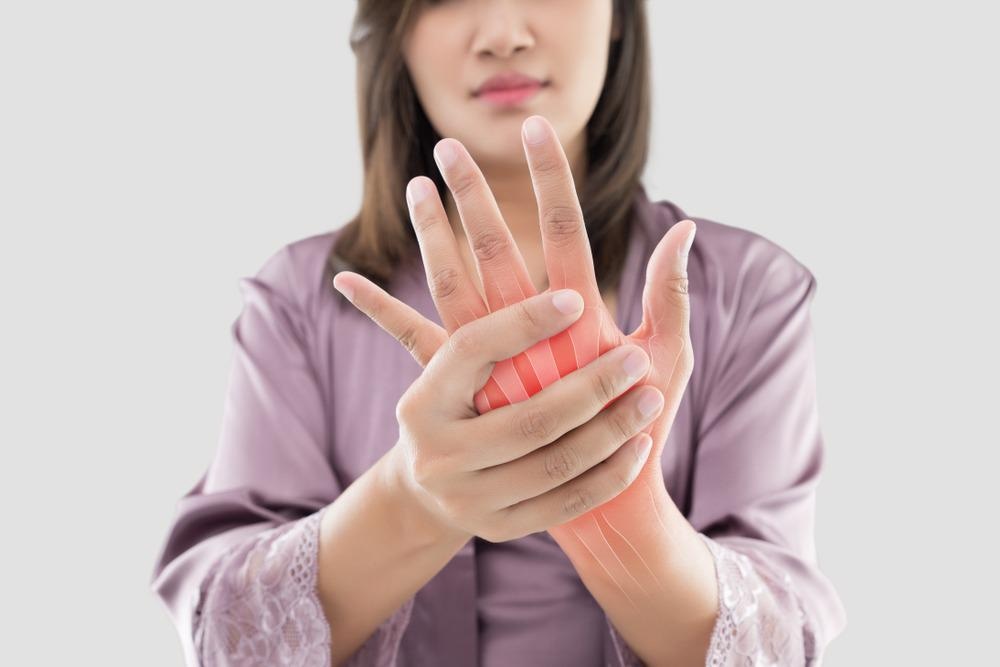The invention of a portable solar-powered centrifuge combined with a nanoplasmonic chip for rheumatoid arthritis diagnostics is the subject of a new study published in the Chemical Engineering Journal.

Study: Combining portable solar-powered centrifuge to nanoplasmonic sensing chip with smartphone reader for rheumatoid arthritis detection. Image Credit: Emily frost/Shutterstock.com
Both the portable centrifuge and the nanoplasmonic sensing chip require minimal energy to function and can provide relief to patients living in remote areas.
Limitations of Currently Used Rheumatoid Arthritis Detection Techniques
Rheumatoid arthritis (RA) is an immunological illness that causes prolonged inflammation and pain. Due to ethnic, climatic, and socioeconomic disparities, the frequency of RA varies greatly across the world.
The well-known current indicators of RA include rheumatoid factor (RF) and anti-citrullinated protein antibodies (ACPAs).
The enzyme-linked immunosorbent test (ELISA) is a widely used method for detecting RF and ACPA, but it requires sophisticated equipment, long operating times, and a very sensitive scanner, all of which are significant impediments to ELISA's use away from state-of-the-art labs.
Development of Nanoplasmonic Sensor Chip
Several biosensors with high sensitivity, such as electrochemical and cantilever beam sensors, can be used in portable systems. However, the majority of these sensors are expensive and difficult to produce in large quantities.
With this in mind, the researchers created a biosensor using a nanoplasmonic metal-deposited chip. The nanoplasmonic sensor chips can be mass-imprinted on polymer materials, and resonant wavelengths can be created using metals like gold or silver to identify biomarkers for rheumatoid arthritis.
A synthetic peptide for collecting autoantibodies for RA diagnosis with high sensitivity was developed and integrated onto the nanoplasmonic sensor for use in RA detection. The sensor's findings can be seen by using red-color intensity pictures on a connected smartphone application.
Production of a Portable Solar-Powered Blood Centrifuge
Centrifuges are fundamentally filtering devices that spin at high speeds and generate considerable centrifugal forces to isolate particles with varying aggregation rates.
They are used to extract blood cells from plasma and may be found in most laboratories and healthcare facilities. However, commercially used blood centrifuges present disadvantages such as high cost and dependence on electricity, making them inappropriate for use in remote areas.
In this study, researchers developed a conveniently managed, energy-efficient, and a mobile centrifuge that can be used as an alternate option for separating blood cells and plasma.
This device can be used in locations with limited energy because of its mini-motor, which a solar-charged battery bank powers. The rotor was created and manufactured using a 3D printing process, and several processes were studied to further enhance this invention. The centrifugal force generated by the machine was powerful enough to produce pure plasma in less than 2 minutes.
The blood of RA patients is taken in a capillary tube. The plasma is separated using a designed centrifuge before being put on a peptide-enhanced nanoplasmonic sensor chip for RA diagnosis. A compact smartphone microscope device is used to measure the information on nanoplasmonic sensor chips.
Research Findings
The centrifuge's optimized rotor arm and angle resulted in a 45% yield rate, 98% purity, and a plasma/blood cell filtration time of under 75 seconds.
A mold-injected nanoplasmonic sensor device was created to measure antibodies in blood samples for a rheumatoid arthritis diagnosis. The nanoplasmonic sensing chip was tested on ten clinically verified RA specimens and ten healthy control specimens.
This work used two sensing methods: peak shift and red-color intensity shift of the nanoplasmonic processor's resonant range. Both sensing techniques produced data that was in excellent agreement with ELISA assays. Furthermore, by combining the smartphone microscope with the solar-powered centrifuge, it can be used successfully for RA diagnosis in remote areas.
Besides providing RA detection services in vulnerable areas, the newly manufactured device is incredibly cost-effective. The manufacturing cost for each nanoplasmonic sensing chip is just 0.2 USD when manufactured using the mold injection method, and the cost of development for the mini-centrifuge is about 10 USD.
The remaining devices, such as the solar panel with an output of 5V, cost 30 USD and the smartphone microscope is readily available for 20 USD. All in all, this novel RA detection device can be manufactured for a minimal price of 60-70 USD.
Continue reading: COVID-19 Detection with Carbon Nanotube Based Biosensors.
References
Dutta, P. et al. (2021) Combining portable solar-powered centrifuge to nanoplasmonic sensing chip with smartphone reader for rheumatoid arthritis detection. Chemical Engineering Journal, 133864. Available at: https://www.sciencedirect.com/science/article/abs/pii/S1385894721054371
Disclaimer: The views expressed here are those of the author expressed in their private capacity and do not necessarily represent the views of AZoM.com Limited T/A AZoNetwork the owner and operator of this website. This disclaimer forms part of the Terms and conditions of use of this website.